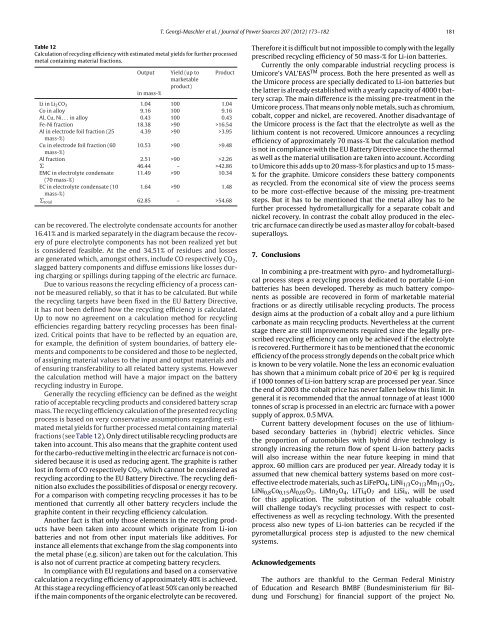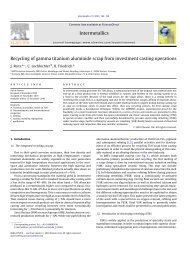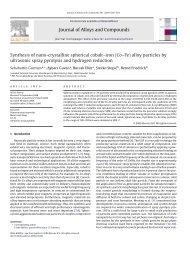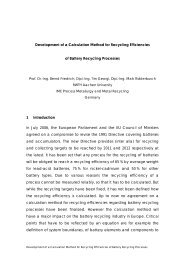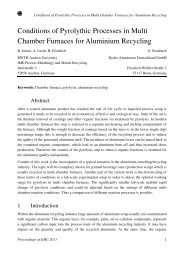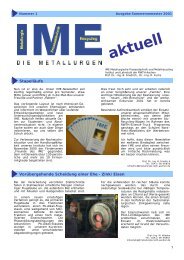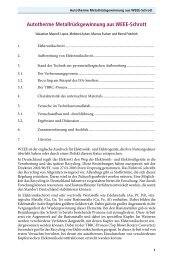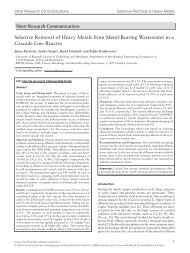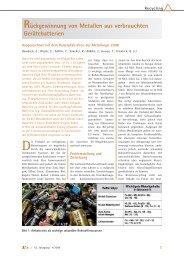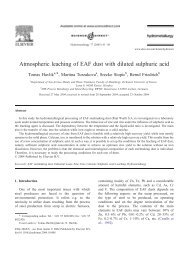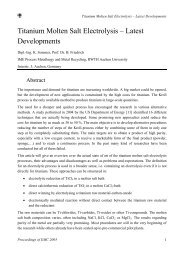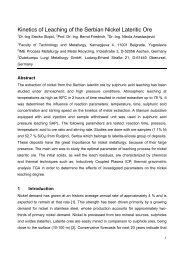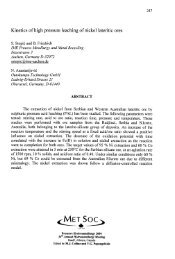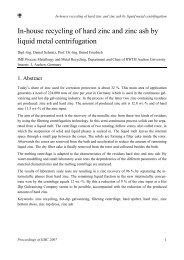Development of a recycling process for Li-ion batteries
Development of a recycling process for Li-ion batteries
Development of a recycling process for Li-ion batteries
- No tags were found...
You also want an ePaper? Increase the reach of your titles
YUMPU automatically turns print PDFs into web optimized ePapers that Google loves.
T. Georgi-Maschler et al. / Journal <strong>of</strong> Power Sources 207 (2012) 173–182 181<br />
Table 12<br />
Calculat<strong>ion</strong> <strong>of</strong> <strong>recycling</strong> efficiency with estimated metal yields <strong>for</strong> further <strong>process</strong>ed<br />
metal containing material fract<strong>ion</strong>s.<br />
Output Yield (up to<br />
marketable<br />
product)<br />
in mass-%<br />
Product<br />
<strong>Li</strong> in <strong>Li</strong> 2CO 3 1.04 100 1.04<br />
Co in alloy 9.16 100 9.16<br />
Al, Cu, Ni. . . in alloy 0.43 100 0.43<br />
Fe-Ni fract<strong>ion</strong> 18.38 >90 >16.54<br />
Al in electrode foil fract<strong>ion</strong> (25<br />
4.39 >90 >3.95<br />
mass-%)<br />
Cu in electrode foil fract<strong>ion</strong> (60 10.53 >90 >9.48<br />
mass-%)<br />
Al fract<strong>ion</strong> 2.51 >90 >2.26<br />
46.44 – >42.86<br />
EMC in electrolyte condensate 11.49 >90 10.34<br />
(70 mass-%)<br />
EC in electrolyte condensate (10 1.64 >90 1.48<br />
mass-%)<br />
total 62.85 – >54.68<br />
can be recovered. The electrolyte condensate accounts <strong>for</strong> another<br />
16.41% and is marked separately in the diagram because the recovery<br />
<strong>of</strong> pure electrolyte components has not been realized yet but<br />
is considered feasible. At the end 34.51% <strong>of</strong> residues and losses<br />
are generated which, amongst others, include CO respectively CO 2 ,<br />
slagged battery components and diffuse emiss<strong>ion</strong>s like losses during<br />
charging or spillings during tapping <strong>of</strong> the electric arc furnace.<br />
Due to various reasons the <strong>recycling</strong> efficiency <strong>of</strong> a <strong>process</strong> cannot<br />
be measured reliably, so that it has to be calculated. But while<br />
the <strong>recycling</strong> targets have been fixed in the EU Battery Directive,<br />
it has not been defined how the <strong>recycling</strong> efficiency is calculated.<br />
Up to now no agreement on a calculat<strong>ion</strong> method <strong>for</strong> <strong>recycling</strong><br />
efficiencies regarding battery <strong>recycling</strong> <strong>process</strong>es has been finalized.<br />
Critical points that have to be reflected by an equat<strong>ion</strong> are,<br />
<strong>for</strong> example, the definit<strong>ion</strong> <strong>of</strong> system boundaries, <strong>of</strong> battery elements<br />
and components to be considered and those to be neglected,<br />
<strong>of</strong> assigning material values to the input and output materials and<br />
<strong>of</strong> ensuring transferability to all related battery systems. However<br />
the calculat<strong>ion</strong> method will have a major impact on the battery<br />
<strong>recycling</strong> industry in Europe.<br />
Generally the <strong>recycling</strong> efficiency can be defined as the weight<br />
ratio <strong>of</strong> acceptable <strong>recycling</strong> products and considered battery scrap<br />
mass. The <strong>recycling</strong> efficiency calculat<strong>ion</strong> <strong>of</strong> the presented <strong>recycling</strong><br />
<strong>process</strong> is based on very conservative assumpt<strong>ion</strong>s regarding estimated<br />
metal yields <strong>for</strong> further <strong>process</strong>ed metal containing material<br />
fract<strong>ion</strong>s (see Table 12). Only direct utilisable <strong>recycling</strong> products are<br />
taken into account. This also means that the graphite content used<br />
<strong>for</strong> the carbo-reductive melting in the electric arc furnace is not considered<br />
because it is used as reducing agent. The graphite is rather<br />
lost in <strong>for</strong>m <strong>of</strong> CO respectively CO 2 , which cannot be considered as<br />
<strong>recycling</strong> according to the EU Battery Directive. The <strong>recycling</strong> definit<strong>ion</strong><br />
also excludes the possibilities <strong>of</strong> disposal or energy recovery.<br />
For a comparison with competing <strong>recycling</strong> <strong>process</strong>es it has to be<br />
ment<strong>ion</strong>ed that currently all other battery recyclers include the<br />
graphite content in their <strong>recycling</strong> efficiency calculat<strong>ion</strong>.<br />
Another fact is that only those elements in the <strong>recycling</strong> products<br />
have been taken into account which originate from <strong>Li</strong>-<strong>ion</strong><br />
<strong>batteries</strong> and not from other input materials like additives. For<br />
instance all elements that exchange from the slag components into<br />
the metal phase (e.g. silicon) are taken out <strong>for</strong> the calculat<strong>ion</strong>. This<br />
is also not <strong>of</strong> current practice at competing battery recyclers.<br />
In compliance with EU regulat<strong>ion</strong>s and based on a conservative<br />
calculat<strong>ion</strong> a <strong>recycling</strong> efficiency <strong>of</strong> approximately 40% is achieved.<br />
At this stage a <strong>recycling</strong> efficiency <strong>of</strong> at least 50% can only be reached<br />
if the main components <strong>of</strong> the organic electrolyte can be recovered.<br />
There<strong>for</strong>e it is difficult but not impossible to comply with the legally<br />
prescribed <strong>recycling</strong> efficiency <strong>of</strong> 50 mass-% <strong>for</strong> <strong>Li</strong>-<strong>ion</strong> <strong>batteries</strong>.<br />
Currently the only comparable industrial <strong>recycling</strong> <strong>process</strong> is<br />
Umicore’s VAL’EAS TM <strong>process</strong>. Both the here presented as well as<br />
the Umicore <strong>process</strong> are specially dedicated to <strong>Li</strong>-<strong>ion</strong> <strong>batteries</strong> but<br />
the latter is already established with a yearly capacity <strong>of</strong> 4000 t battery<br />
scrap. The main difference is the missing pre-treatment in the<br />
Umicore <strong>process</strong>. That means only noble metals, such as chromium,<br />
cobalt, copper and nickel, are recovered. Another disadvantage <strong>of</strong><br />
the Umicore <strong>process</strong> is the fact that the electrolyte as well as the<br />
lithium content is not recovered. Umicore announces a <strong>recycling</strong><br />
efficiency <strong>of</strong> approximately 70 mass-% but the calculat<strong>ion</strong> method<br />
is not in compliance with the EU Battery Directive since the thermal<br />
as well as the material utilisat<strong>ion</strong> are taken into account. According<br />
to Umicore this adds up to 20 mass-% <strong>for</strong> plastics and up to 15 mass-<br />
% <strong>for</strong> the graphite. Umicore considers these battery components<br />
as recycled. From the economical site <strong>of</strong> view the <strong>process</strong> seems<br />
to be more cost-effective because <strong>of</strong> the missing pre-treatment<br />
steps. But it has to be ment<strong>ion</strong>ed that the metal alloy has to be<br />
further <strong>process</strong>ed hydrometallurgically <strong>for</strong> a separate cobalt and<br />
nickel recovery. In contrast the cobalt alloy produced in the electric<br />
arc furnace can directly be used as master alloy <strong>for</strong> cobalt-based<br />
superalloys.<br />
7. Conclus<strong>ion</strong>s<br />
In combining a pre-treatment with pyro- and hydrometallurgical<br />
<strong>process</strong> steps a <strong>recycling</strong> <strong>process</strong> dedicated to portable <strong>Li</strong>-<strong>ion</strong><br />
<strong>batteries</strong> has been developed. Thereby as much battery components<br />
as possible are recovered in <strong>for</strong>m <strong>of</strong> marketable material<br />
fract<strong>ion</strong>s or as directly utilisable <strong>recycling</strong> products. The <strong>process</strong><br />
design aims at the product<strong>ion</strong> <strong>of</strong> a cobalt alloy and a pure lithium<br />
carbonate as main <strong>recycling</strong> products. Nevertheless at the current<br />
stage there are still improvements required since the legally prescribed<br />
<strong>recycling</strong> efficiency can only be achieved if the electrolyte<br />
is recovered. Furthermore it has to be ment<strong>ion</strong>ed that the economic<br />
efficiency <strong>of</strong> the <strong>process</strong> strongly depends on the cobalt price which<br />
is known to be very volatile. None the less an economic evaluat<strong>ion</strong><br />
has shown that a minimum cobalt price <strong>of</strong> 20 D per kg is required<br />
if 1000 tonnes <strong>of</strong> <strong>Li</strong>-<strong>ion</strong> battery scrap are <strong>process</strong>ed per year. Since<br />
the end <strong>of</strong> 2003 the cobalt price has never fallen below this limit. In<br />
general it is recommended that the annual tonnage <strong>of</strong> at least 1000<br />
tonnes <strong>of</strong> scrap is <strong>process</strong>ed in an electric arc furnace with a power<br />
supply <strong>of</strong> approx. 0.5 MVA.<br />
Current battery development focuses on the use <strong>of</strong> lithiumbased<br />
secondary <strong>batteries</strong> in (hybrid) electric vehicles. Since<br />
the proport<strong>ion</strong> <strong>of</strong> automobiles with hybrid drive technology is<br />
strongly increasing the return flow <strong>of</strong> spent <strong>Li</strong>-<strong>ion</strong> battery packs<br />
will also increase within the near future keeping in mind that<br />
approx. 60 mill<strong>ion</strong> cars are produced per year. Already today it is<br />
assumed that new chemical battery systems based on more costeffective<br />
electrode materials, such as <strong>Li</strong>FePO 4 , <strong>Li</strong>Ni 1/3 Co 1/3 Mn 1/3 O 2 ,<br />
<strong>Li</strong>Ni 0,8 Co 0,15 Al 0,05 O 2 , <strong>Li</strong>Mn 2 O 4 , <strong>Li</strong>Ti 4 O 7 and <strong>Li</strong>Si x , will be used<br />
<strong>for</strong> this applicat<strong>ion</strong>. The substitut<strong>ion</strong> <strong>of</strong> the valuable cobalt<br />
will challenge today’s <strong>recycling</strong> <strong>process</strong>es with respect to costeffectiveness<br />
as well as <strong>recycling</strong> technology. With the presented<br />
<strong>process</strong> also new types <strong>of</strong> <strong>Li</strong>-<strong>ion</strong> <strong>batteries</strong> can be recycled if the<br />
pyrometallurgical <strong>process</strong> step is adjusted to the new chemical<br />
systems.<br />
Acknowledgements<br />
The authors are thankful to the German Federal Ministry<br />
<strong>of</strong> Educat<strong>ion</strong> and Research BMBF (Bundesministerium für Bildung<br />
und Forschung) <strong>for</strong> financial support <strong>of</strong> the project No.


